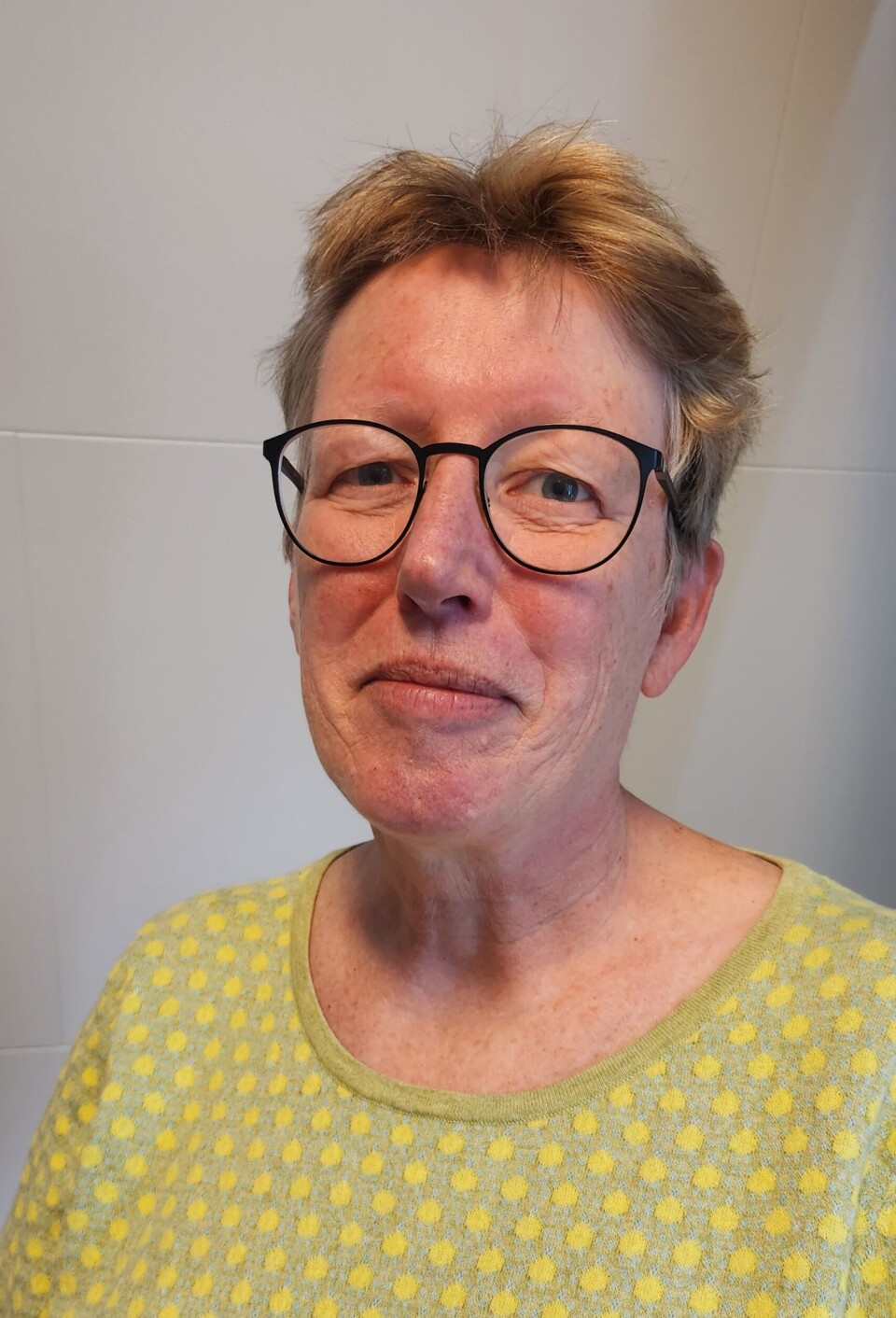
Victoria Augustine falls ill from everyday activities like taking a shower or family visits:
“I end up bedridden with a feverish feeling and body aches"
Physical and social activities are healthy for everyone. What's life like when you can't tolerate them?
Victoria Augustine Trulsen, 25, can remember the first time she thought: This can't be normal.
She had been struggling for a while after having mononucleosis. But there was never any doubt that when autumn came, Trulsen would start 10th grade – the final year of lower secondary school.
However, that plan crashed already on the first day of school.
“I managed half a day of school. Then I just had to go home, and I was bedridden afterwards. It was really scary,” Trulsen tells sciencenorway.no.
“At first, I clung to what the doctors said – that you can be unwell for a long time after mono. I'm glad I didn't know it would last this long.”
This was the start of a period where Trulsen was very ill. She spent most of her time in bed and was unable to complete the school year. She was eventually diagnosed with ME/CFS.
Post-exertional malaise – PEM
ME/CFS is a chronic, complex illness that affects many of the body's systems, such as the immune system and central nervous system. The illness varies in severity, but can result in significantly reduced health, quality of life, and function.
According to the Norwegian Directorate of Health's national guidelines, people with ME/CFS on average have significantly lower functional levels and quality of life than patients with cancer, depression, or arthritis.
A peculiar feature of ME/CFS is precisely what Trulsen experienced in connection with her first day of school:
Exertion-induced worsening of symptions – also called PEM (post-exertional malaise).
PEM occurs after everyday physical or mental exertion and can cause the patient to feel unwell. If people with ME/CFS clearly exceed their own tolerance limit for activity, they may subsequently experience a severe worsening of a range of symptoms, which often lasts for several days, or in the worst case, weeks.
“PEM is the strangest and most characteristic symptom of ME/CFS,” says Kristian Sommerfelt, a paediatrician and senior physician at the Østfold Hospital Trust Kalnes and professor emeritus at the University of Bergen.
He has treated many ME/CFS patients over the years.
Taking a shower is sometimes all it takes
PEM is a core symptom of ME/CFS, and is required for a diagnosis of ME in the most commonly used diagnostic criteria. It has also been reported that people with long Covid, multiple sclerosis, and fibromyalgia sometimes experience PEM.
How much activity beyond a patient’s own personal capacity triggers the phenomenon varies from patient to patient.
For some, the crash may come after a social event at school or a shopping trip, according to the CDC Public Health and Data Authority on their recently updated ME/CFS pages.

Taking a shower or too much noise and light can be enough to completely knock out the most severely affected patients for days or weeks.
Trulsen is better today than she was immediately after having mononucleosis, but still notes that it does not take much to trigger a PEM episode.
Facial swelling
“Anything from weeding the garden to sitting in the sun for too long can bring on PEM for me,” says Trulsen.
What's extra frustrating is that it doesn't matter if she is doing enjoyable things or chores.
“People wonder why you can’t focus on things you like, so they can give you a surplus of energy. But the consequences are just as great when I visit a friend as when I go to a doctor's appointment,” she says.
She frequently exceeds the limits of what she can tolerate, and then the first symptoms appear.
“My pulse rises, and my face swells up. My skin becomes red and shiny. My hands shake, and my body starts to ache. Then I lie down if I can. I draw the curtains and put in earplugs,” says Trulsen.
Sometimes she manages to save herself and avoid crashing. But it's not that easy.
“You want to do so much. I live a bit on adrenaline and just want to take care of this or that task,” says Trulsen.
The result can be a serious PEM episode.
Extremely ill
People with ME/CFS describe PEM crashes as an almost paralysing exhaustion, along with a range of symptoms such as pain and flu-like feelings.
“You feel extremely ill. I end up bedridden with a feverish feeling and body aches that nothing can alleviate," says Trulsen.
“My legs are heavy as lead, and my hands tremble just from lifting my phone. Light and sound hurt my eyes and ears, and my brain feels like cotton. I have trouble finding words. I want to sleep to escape for a few hours, but then I can't fall asleep either.”
Pushing, persuading, and cheering – come on, you can do this, just a little more – is one of the most dangerous things you can do.
Kari Cotton, ME/CFS patient
“And when I do fall asleep, it doesn't help. I'm just as exhausted when I wake up again,” Trulsen says.
These are typical symptoms of PEM that ME/CFS patients have described in many different studies.
Many also struggle with a high pulse, stiff neck, sore throat, nausea, and sore lymph glands, according to a survey of patients from 2021.
The researchers behind a 2020 study write that patients describe PEM as something that can affect all parts of the body, is difficult to predict and manage, and which requires rest, often by lying down, to fully or partially recover.
Much more than just being tired and exhausted
PEM is not about being tired, like healthy people might feel after a long mountain hike or a really hard week at work.
“Everyone can feel fatigued, but this is something completely different,” says Nina Vøllestad, a professor at the University of Oslo.
She and her colleague Anne Marit Mengshoel have written a report on PEM, which was published in Frontiers in Physiology in 2023.

“Many can’t get out of bed and describe themselves as almost dead,” she tells sciencenorway.no.
Vøllestad explains that many patients use specific terms to distinguish the fatigue they normally have from what they experience during PEM.
“During periods when ME/CFS patients are quite well, they describe it as ordinary fatigue, but when they get PEM, they use the term exhaustion – a total depletion of energy," she says.
What are the recommendations?
Researchers have conducted several new studies on PEM in recent years. Some of them provide hints about the mechanisms that might be behind it.
But for now, researchers do not know what causes this strange phenomenon. There is also no effective treatment for PEM.
However, there are strategies that patients can use to experience fewer PEM episodes and live better with the illness.
Many expert organisations today advise helping patients regulate their activity so that they do not exceed their own tolerance limits and trigger PEM. This is often called pacing and is recommended, for example, by the CDC in the USA, NICE in the UK, a consensus statement from the European research network EUROMENE, a joint consensus statement from experts in Germany, Austria and Switzerland and guidance on ME/CFS from the Norwegian Directorate of Health.
Researchers behind a new proposal for recommendations for long Covid patients are also clear that treatment should consider whether the patient has PEM or not.
Maximising activity – without PEM
Pacing often involves measures to conserve energy, such as using assistive devices and avoiding unnecessary activity. It is also important to spread activities throughout the day with enough breaks in between.
'Any measure that can prevent a worsening of symptoms will not only stabilise the condition but also reduce discomfort and improve the patient's quality of life,' according to the guidelines from the Norwegian Directorate of Health.
Paradoxically, a study of long Covid patients with PEM suggests that pacing may also lead to more activity for some patients. After six weeks of activity management patients had far fewer PEM episodes but a higher level of activity.
The goal is not for ME/CFS and long Covid patients to be as inactive as possible.
There is no reason to believe that inactivity itself is healthy for sick individuals. On the contrary, a study from 2021 suggested that exercise had positive effects on the health of ME/CFS patients when they did not exceed their limits. But the same study also showed that half of the patients could not tolerate the exercise programme the researchers had set up.
Healthcare providers need to be aware that their patients' ability to function may seriously deteriorate if they exceed their individual capacity, the CDC writes in its guidelines.
In general, patients should not push themselves beyond their limits, as this can worsen symptoms and trigger PEM. When patients improve, activities can be increased gradually while monitoring for any negative effects, according to the CDC.
Taxi to school
The ideal is therefore to find a level of activity that allows the greatest possible health, function, and quality of life without triggering PEM. This applies not only to physical activity, but also to social and mental engagement.
The challenge for ME/CFS patients is that all activity draws energy from the same reservoir.
Increasing physical activity may mean that patients have to cut back on social or mental activities. Situations that involve both physical and social activity draw twice as much energy.
This means that daily life must be carefully planned and adapted to prevent patients from pushing themselves too far and getting worse.
Sommerfelt gives an example:
“Take young people with ME/CFS who want to go to school and have enough capacity for some school attendance. You could achieve this by having them attend three half days of school per week, but then it would be crucial for them to take a taxi alone to and from school.”
Solutions like this actually helped Trulsen eventually complete upper secondary school.
“It was very demanding. I took a taxi to and from school and spent the rest of the day resting. But I had to make it work. I figured that I was going to get better eventually, and then it's good to have study qualifications,” she says.
Delayed reaction
However, pacing is not as easy to achieve as we might think.
A characteristic feature of PEM is that the reaction to activity is often delayed. It can come several hours after the activity itself. Often, the reaction does not fully set in until the next day. Additionally, the amount of energy you have at your disposal can vary from day to day.
This variability makes it extra difficult to know which activities one can tolerate and how much activity triggers PEM.
Kari Cotton, 61, has had ME/CFS for eight years but still finds it difficult to maintain the right balance between activity and rest.
Before Cotton contracted ME/CFS, she worked as head of the Jotun research library and had a lot of hobbies.

Now, Cotton’s challenge is to do little enough to avoid PEM. Most of the time, she manages to avoid the big crashes. But a couple of times a year, she goes through a severe episode. Then she ends up lying in bed for several days with chills, headaches, tremors, and body aches.
“I know deep down that when I take more breaks, I get more done,” Cotton tells sciencenorway.no.
“What I need to do to avoid PEM is to take breaks while I'm still in good shape. But it requires immense discipline. It's so boring and frustrating!” she says.
Drained by physical, social, and emotional activity
Taking breaks needs to happen not only during physical activity, but also during mental and social activities, such as reading or having a conversation with a friend.
And this applies just as much to enjoyable activities. ME/CFS patients can get PEM from being really happy or doing something they love for too long.
“I’ve spent large parts of my life with a responsible job and lots of hobbies, like knitting, sewing, gardening, carpentry, and painting. I still want to do these things, and often I can't hold back enough,” says Cotton.
“The ideal might be to work in the garden for 15 minutes and then take a 10-minute break. But suddenly, half an hour has gone by,” she says.
Cotton often experiences the first signs of overexertion, such as weakness and difficulty thinking clearly. Most of the time, she manages to stop what she’s doing before she triggers the really big crashes.
Everyone does too much sometimes
“It’s important to learn to live without triggering PEM. But at the same time, it’s wise not to be frightened of PEM. I often say: If there's something you really want to be a part of, it's okay to risk some worsening of symptoms, but don't do it regularly. I strongly advise against doing something that causes PEM every week," says paediatrician Kristian Sommerfelt.
It’s not a bad idea to occasionally test to see if your condition has improved, so that you might be able to increase your activity level carefully.
But Sommerfelt believes this happens by itself.
“I haven’t met a single patient who doesn't occasionally exceed the level of activity they can tolerate and trigger PEM,” he says.
Sommerfelt believes the problem is rather that ME/CFS patients are pressured into too much activity, both by the healthcare system and in contact with agencies like the Norwegian Labour and Welfare Administration (NAV).
This can lead to repeated PEM crashes and increasingly poor health, he says.
PEM is often not discussed
Knowledge of both ME/CFS and PEM is often lacking among healthcare personnel, says Marjon Wormgoor at Vestfold Hospital Trust.
Wormgoor and her colleague Sanne Rodenburg from the Netherlands recently reviewed data from two surveys of ME/CFS patients who had been to consultations, treatments, or coping courses at hospitals in Vestfold and Telemark counties, or had stayed at a rehabilitation institution in Norway. The surveys were carried out by the Norwegian ME Association.

The results showed that PEM was addressed in only about half of the cases. Patients were more satisfied and reported greater benefits from their treatment when healthcare professionals focused on PEM.
In the cases where PEM was not discussed, twice as many patients reported worse health for a long time after treatment.
Wormgoor became interested in the topic when her son was diagnosed with ME/CFS. Today, she is also a board member of the regional ME/CFS association in Vestfold.
“For the last 20 years, it’s been clear that PEM is a core symptom of ME. But a lot of people in the healthcare system still haven’t heard of it or don’t understand the significant impact PEM has on the patient's functional state,” she says.
Another study from the FAFO research foundation confirms that PEM creates problems in the interaction between patients and the healthcare system.
The survey of 660 Norwegian ME/CFS patients showed that most participants felt the treatment provided little benefit and often made them worse. The more PEM impacted patients, the more negative their experience with many types of treatment, especially physiotherapy, cognitive behavioural therapy, and rehabilitation stays.
Cheering doesn't help
Sommerfelt believes part of the problem is that PEM is often completely invisible to others.
“During an activity, it's not possible for others to notice that someone has gone over their limit," he says.
And when the crash comes, perhaps the next day, no one notices that the person is in bed and feeling terribly unwell.
Many ME/CFS patients have expressed that they wish other people could understand how profoundly ill they become.
Cotton would like people to understand that cheering them on doesn't help.
We are so used to thinking that it is healthy and positive to push ourselves. We cheer and motivate each other to keep going. But for people with PEM, the effect can be the exact opposite, Cotton believes.
“Pushing, persuading, and cheering – come on, you can do this, just a little more – is one of the most dangerous things you can do. By exceeding our tolerance limit over time, we risk long-term deterioration,” she says.
“Instead, we need those around us to encourage us to rest and take breaks. We need to hear them say: 'Sit down, put on sunglasses, go and rest for fifteen minutes!' And then you can come back so we can be together again afterwards," she says.
———
Translated by Ingrid P. Nuse
Read the Norwegian version of this article on forskning.no






































